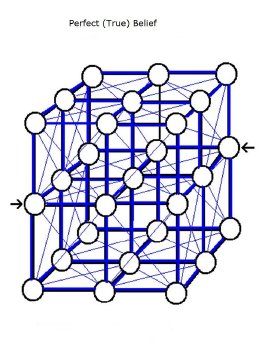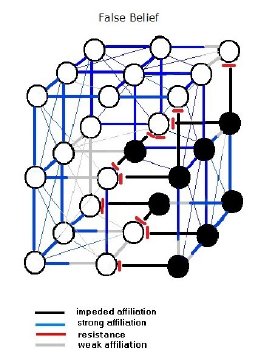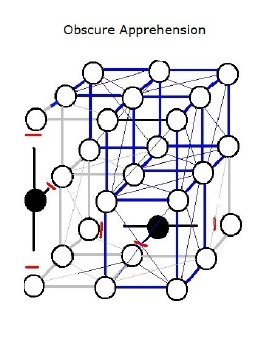My repeated attempts to persuade Prismatic to address my proof that the position he has taken in multiple posts in multiple threads—that the idea of God is an impossibility—was posed repeatedly here to demonstrate the process by which value mechanics (or spiritual mechanics), posted in the op, functions. I ran across some old graphics (see below) made years ago that might help clarify. (Apologies for their crudity; I’m neither an artist or particularly skilled on the computer beyond word processing.)
Each circle in the graphics represents an iota of information. White iotas exist in a true condition, black are false. The Obscure Apprehension graphic symbolizes a sample of the general content of a soul or intellect—living information—as it exists in a fragmentally falsified condition. The other two represent illustrations of true and false informational belief states within the intellect. In the case of obscure apprehension, the diagram illustrates how value affects cognitive functions generally, the other two more specifically.
The reception of false descriptive propositions in cognition (4+4=6, the surface temperature of the sun is 128.5 degrees Fahrenheit) produce only a mild cognitive tension. Factual reality is essentially inert (no ought from is). One reason for this may be that the actual falsity or state of falsification which produces factual error is peculiar to the animated intellect. Because the animating principle of the agent is prescriptive and falsifiable—and the descriptive information she processes possesses value different in kind and immutably true—its mathematical patterning (or some combination of matter’s features) in apprehension of the t¬f discord in descriptive propositions may be automatically intuited [the sense or discovery of error] as just a feature of internal dysfunction absent of moralistic force.
But discord raised in prescriptive (or prescript-affiliated) propositions go beyond mere tension to produce a much more robust resistance, and are of primary interest here. Prismatic’s responses to the proof provided—assuming this proofs is true in the whole, i.e., the proposition that God is an impossibility is a demonstrable error—illustrates the power of prescriptive truth in connection with one or more insuperable false beliefs (IFB).
Prismatic’s oft-repeated claims—“I have not come across any poster here who has cracked my argument ‘God is an Impossibility.’”—and subsequent responses to requests to repent of this claim on the basis of proffered evidence to the contrary provides an example of how the IFB functions.
The strength of an IFB in the f[1]f[/i] union is such that its holder, unable to form a proper t[2]t[/i] synthesis, will perform any of a number of evasive maneuvers to avoid the t¬f pressure true prescriptive propositions convey to the IFB. This pressure is illustrated by the multiple red lines of resistance between the IFB and surrounding true information in the False Belief graphic. Prismatic’s responses to repeated presentation of the truth-bearing rebuttal of his ‘God is impossible’ claim can be read in posts above to corroborate these principles. Most here have had enough experience with different personalities in life’s conversations and in message board dialog to recognize the their applicability here.
In an aside, it seems plausible that in prescriptive matters the holding of one or more false beliefs by agent “A” that are provably wrong lends credence to the notion that some significant quantity of the associated set of beliefs “A” draws from his worldview—which stand in various degrees of difficulty to disprove—to support his provably wrong beliefs, are themselves largely or wholly false as well by virtue of their standing in the same category of moral (dis)belief, and are likely to have been developed by motives similar to those used to develop and hold his provably erroneous IFBs.
While this seems intuitively true, the issue is more complicated. Virtually all atheists also hold moral beliefs in common with their theist brethren—i.e., beliefs that justice is a good that should prevail, murder and rape are wrong, humans are innately entitled to certain rights (though the rights applicable to this set are controversial), etc. Theists also hold IFBs and these inevitably enter into their moral and ethical discussions. And the issue is made more difficult by the general obscurity fragmental falsification in essence imposes on one’s ability to acquire, process and rationalize external and internal information, again referencing the Obscure Apprehension graphic.
It’s hypothesized here that the power of prescriptive value drives motives, and causally the majority of human behavior. Value interactions can explain why some minds tend toward philosophies like physicalism, materialism, relativism, etc.—worldviews that strongly embrace human autonomy—while others tend toward philosophies which stand in degrees of opposition in one or more respects to them.
The False Belief graphic illustrates some features for how an IFB affects other functions. While resistance excludes any possibility of union between the two, the IFB differs from one’s natural “fragmentally falsified” state in that the fragmental state only creates impedance to clear thought [and probably degrees of impurity to proper function of emotions], producing only mild dispositions to reject propositional truths over falsehoods. This would be the case in granting credence to a falsehood because of insufficient information or due to vagueness of the truth of a matter imposed by t-f impedance (weak value affiliations).
IFBs might be thought of as “clusters” of concentrated falsity. An analogy is that beliefs that populate a worldview are like pages in a manila folder. It’s generally held that if consistently pursued, wrong choice leads to a process of cognitive “deadening”, or increase of predilection away from what a consensus of reasonable agents would deem proper and appropriate lifestyle preferences, as for example the choice to experiment with drugs is thought to sometimes lead to heavier usage and eventual addiction. Following this pattern, frequent wrong choice leads to an informational state in which sufficient falsity is generated with respect to a certain belief that it saturates and occupies a page [one belief] in a folder [worldview]. An agent logically exists in some established quantity or amount of information, so that falsification is not added to essence, existing truth-bearing iotas are rendered false. We exist as contiguous information packages, in various percentages of true and false value.
In the possession of IFBs, the t[3]t[/i] union is lost, and the t¬f conflict common to simple contemplation in prescriptive issues morphs into a f[4]f[/i] union by repeated willful subjection to propositional falsity. In the IFB, a false belief is established and held as true, and ensuing energies applied to the topic are thereafter exercised by the holder in trying to produce true propositions in support of it. The natural loss of affiliation between true and false information would be naturally imposed on apprehension by the juxtaposition of opposite values within the information of the whole; these would contribute to the mind’s ability to live with disparate prescriptive beliefs—if we can’t clearly “see” the contradictions in our worldviews, we aren’t forced to deal with them.
Prismatic’s contrived rationale (falsely imposed logical fallacy as a pretext of refutation) is a common diversion employed by an agent whose allegiance to his IFB (and affiliated system of false beliefs) shrinks from truth it cannot unite with. The true-false moral opposition is every bit as strong as its material [electromagnetic] plus-minus value counterpart. Prismatic’s unwillingness to concede the truth of the evidence presented is based on an inability to overcome the strong f[5]f[/i] link to unite with the truth in the proposition offered.
It follows from the principles suggested that societal norms, because they’re formed by the predispositions appropriate to the truth- or falsity-bearingness of its members, will reflect these accrued values and either advance toward the establishment and maintenance of true ethical/moral models or deteriorate in the direction of further falsehoods. It should be obvious that increases in holding to the false are inevitably directed to moral/behavioral deterioration and eventual chaos, while progression toward truth-bearing ideals results in advancement of the good.


